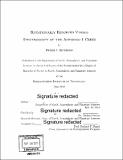Rotationally resolved visible spectroscopy of the Asteroid 1 Ceres
Author(s)
Henderson, Phoebe J
DownloadFull printable version (3.300Mb)
Other Contributors
Massachusetts Institute of Technology. Department of Earth, Atmospheric, and Planetary Sciences.
Advisor
Michael Person.
Terms of use
Metadata
Show full item recordAbstract
This thesis was designed to make spectroscopic measurements of Ceres within the visible spectrum, specifically within the wavelength range of 6000 and 7000 Angstroms. The asteroid was observed for 6 nights, for lengths of time varying from 3 to 7.5 hours. The main goal was to support/refute the previous findings about absorption features within the wavelength range being observed. Additionally, this thesis was designed to determine the rotational variability of minerals on Ceres. In order to determine the asteroid's variablity, the rotational period of Ceres was divided into eight phases, and average spectra were determined for each phase. The results show that there is a weak rotational variability of the feature between 6200 and 6400 Angstroms. The feature varies over the surface of Ceres by 2.5% with a mean error of 1.6%. There have been previous reports of absorption features on asteroids between 6000 and 6500 Angstroms, which have been associated with ferric Fe absorptions in Fe alteration minerals. Examples of such minerals include goethite and iron oxide hematite.
Description
Thesis: S.B., Massachusetts Institute of Technology, Department of Earth, Atmospheric, and Planetary Sciences, 2013. "June 2013." Cataloged from PDF version of thesis. Includes bibliographical references (pages 23-24).
Date issued
2013Department
Massachusetts Institute of Technology. Department of Earth, Atmospheric, and Planetary SciencesPublisher
Massachusetts Institute of Technology
Keywords
Earth, Atmospheric, and Planetary Sciences.